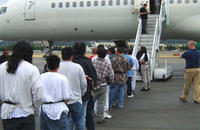-
Immigrants held for days in freezing, unsanitary cells file class-action lawsuit
Tucson Sector Border Patrol holds men, women, and children in freezing, overcrowded, and filthy cells for extended periods of time in violation of the U.S. Constitution, a group of legal organizations allege in a class-action lawsuit filed Monday. The class-action suit, which was filed on behalf of two people detained in the Tucson Border Patrol Station as well as a Tucson man detained multiple times in that facility, describes Border Patrol limiting or denying access to beds, soap, showers, adequate meals and water, medical care, and lawyers, in violation of constitutional standards and Border Patrol’s own policies.
-
-
Divided court denies emergency stay of injunction stopping Obama's immigration executive order
In a disappointing decision for immigration advocates, a divided panel of the Fifth Circuit Court of Appeals yesterday denied the federal government’s request for an emergency stay of a preliminary injunction which has temporarily stopped President Obama’s deferred action initiatives from being implemented. The court’s order keeps in place the hold on implementation of these initiatives while the Fifth Circuit considers the appeal of the preliminary injunction itself. The Fifth Circuit will hear argument on the appeal in early July.
-
-
Improving the legal status of undocumented immigrants beneficial to U.S.: Expert
In 2012 the administration announced two executive orders — the Deferred Action for Childhood Arrivals (DACA) and the Deferred Action for Parental Accountability (DAPA) — aiming to facilitate the legalization of status of certain groups of undocumented immigrants. An immigration scholar believes that if Obama’s proposed expansion of DACA and the creation of DAPA survive current legal challenges, they could form the foundation for permanent immigration reform. She also says that decades of research show that easing consequences for people in the United States illegally will not encourage more people to come here illegally. Contrary to public opinion, welfare levels and benefits in the United States do not affect migration flows, which are more influenced by economic conditions in the United States and the migrants’ home countries.
-
-
ICE to review conditions in detention centers housing women, children
U.S. Immigration and Customs Enforcement (ICE), pending a judge’s decision on the legality of immigration detention centers, will appoint an in-house official to review living conditions at three detention centers in Texas and Pennsylvania used to house women and children who illegally crossed the southern border. Immigrant rights advocates, who have sued to end the detention of families, called the announcement made last Wednesday insufficient.
-
-
DHS implements new deportation scheme to replace Secure Communities
After months of working to improve Secure Communities, the Obama administration recently announced the Priority Enforcement Program, under which jails will be asked to notify ICE agents when a deportable immigrant will be released — so agents can be waiting — instead of holding him or her in jail until ICE agents arrive. This new approach is a response to criticism of Secure Communities from local law enforcement units that said the program strained local budgets as jails became overbooked with nonviolent criminals.
-
-
House Democrats write court in support of Obama’s immigration executive order
On Monday, 181 Democratic House members filed a joint amicus brief, telling the U.S. Court of Appeals for the 5th Circuitthat the executive branch has the authority to make certain policy changes on immigration matters. Specifically, they noted that that the enforcement of immigration laws and the deferral of certain deportations are within the discretion of the executive branch. The lawmakers added that the White House is often better positioned than Congress to determine how to adjust immigration laws.
-
-
McConnell’s DHS budget plan: “No” to 2014 exec. order, “Yes” to 2012 one
Senate Majority Leader Mitch McConnell (R-Kentucky) has put forth a plan to avoid a DHS shutdown after Senate Democrats on Monday refused to approve a Republican-backed $40 billion DHS appropriation which would defund President Barack Obama’s 2014 immigration actions in order to fund DHS. McConnell’s plan would eliminate Obama’s 2014 immigration action to extend deportation deferment to some undocumented parents of U.S. citizens and permanent residents via the Deferred Action for Parents of Americans(DAPA), but allow a similar 2012 planfor younger undocumented immigrants to continue.
-
-
Federal judge in Texas temporarily blocks Obama’s executive order
Late Monday night, U.S. District Judge Andrew Hanen, a George W. Bush appointee and an outspoken critic of the administration’s immigration policies, temporarily blocked President Barack Obama’s executive action to offer deferred deportation to roughly five million undocumented immigrants. Had Hanen not approved an injunction against Obama’s orders, the U.S. Citizenship and Immigration Services, on Wednesday ,18 February, would have begun accepting applications from those eligible for an extension of DACA.
-
-
Police chiefs, sheriffs in major U.S. cities support immigration executive order
Twenty-seven chiefs of police and sheriffs from U.S. cities — including Los Angeles, Dallas, Denver, and Washington, D.C.— have joined the Major Cities Chiefs Associationto defend President Barack Obama’s executive order which extends deferred deportation to about five million undocumented immigrants. Many law enforcement officers around the country argue that Obama’s order will improve public safety by allowing many undocumented immigrants to feel secure enough to approach local police. They are more likely to report crime without fear of deportation, police chiefs and sheriffs assert.
-
-
USCIS tries to avoid HealthCare.gov-like problems in implementing executive order
President Barack Obama announced the Deferred Action for Parental Accountability(DAPA) initiative on 20 November, and a day later, USCIS began to publish job postings seeking individuals to help with the rollout. Applicants who qualify for DAPA still have until May 2015 before they may apply, but immigration officials are taking a proactive approach and anticipating a large number of applications in order to avoid the mistakes made during the Obama administration’s launch of HealthCare.gov.
-
-
USCIS looking to fill 1,000 positions in response to Obama’s executive order
An internal memo from the U.S. Citizenship and Immigration Services (USCIS) notes that the federal government is seeking to fill 1,000 full-time permanent and temporary positions at a new “operational center” in Crystal City, Arlington, Virginia, in response to the Obama administration’s executive actions to allow some five million undocumented immigrants have their deportation deferred, apply for driver’s licenses in most states, and apply for two-year work permits.
-
-
Obama’s executive action may divert resources from handling legal immigrants

Critics of President Barack Obama’s executive order on immigration are worried that shifting immigration resources from work done on behalf of legal immigrants to applications filed by those in the country illegally would discourage future immigrants from entering the United States legally.A former federal immigration official compares the new immigration effort to the 2012 Deferred Action for Childhood Arrival program (DACA), which drew more than 600,000 applications from Dreamers.One of the effects of DACA was an increase in the wait time for green cards for immigrant spouses of U.S. citizens from five months to fifteen months, which critics blame on personnel being diverted to work on the DACA program.
-
-
Number of unaccompanied children crossing into U.S. declines sharply

The number of unaccompanied children apprehended by federal agents along the U.S.-Mexico border last October was down by 40 percent compared with October 2013. In the nine sectors of the Southwest border from California to Texas, federal border officials apprehended 2,529 children last October, down from 4,181 in October 2013. Family apprehensions also decreased about 10 percent — from 2,414 in October 2013 to 2,163 in October 2014.
-
-
Immigration advocates say CBP uses "expedited removal" to deport asylum seekers

A new complaint to the DHS Office of Civil Rights and Civil Liberties charge sthat U.S. Customs and Border Protection(CBP) agents routinely ignore asylum seekers’ claim of fear of prosecution in their homeland, a claim which could grant them asylum in the United States. The complaint further states that CBP officers are increasingly using “expedited removal” to deport illegal immigrants. Unlike conventional deportation, expedited removal occurs outside of the judicial process. The number of expedited removal orders more than doubled in less than a decade from 72,911 in 2005 to 193,092 in 2013.
-
-
Immigration hearings hampered by remote technology glitches, raising constitutional issues
The are currently nearly 400,000 pending deportation cases, shared among just 230 immigration judges in fifty-nine courtrooms. Immigration cases in the southern United States are encountering increasing delays and hardships due to the necessity of having to rely on wireless and mobile technology in order to have proper communication in the courtroom. Some even worry that the problems with the systems in place, including interpreters using teleconference equipment to translate large statements at a time, may be used in appeals on grounds that it is unconstitutional.
-
- All
- Regional
- Water
- Biometrics
- Borders/Immig
- Business
- Cybersecurity
- Detection
- Disasters
- Government
- Infrastructure
- International
- Public health
- Public Safety
- Communication interoperabillity
- Emergency services
- Emergency medical services
- Fire
- First response
- IEDs
- Law Enforcement
- Law Enforcement Technology
- Military technology
- Nonlethal weapons
- Nuclear weapons
- Personal protection equipment
- Police
- Notification /alert systems
- Situational awareness
- Weapons systems
- Sci-Tech
- Sector Reports
- Surveillance
- Transportation
Advertising & Marketing: advertise@newswirepubs.com
Editorial: editor@newswirepubs.com
General: info@newswirepubs.com
2010-2011 © News Wire Publications, LLC News Wire Publications, LLC
220 Old Country Road | Suite 200 | Mineola | New York | 11501
Permissions and Policies
Editorial: editor@newswirepubs.com
General: info@newswirepubs.com
2010-2011 © News Wire Publications, LLC News Wire Publications, LLC
220 Old Country Road | Suite 200 | Mineola | New York | 11501
Permissions and Policies
